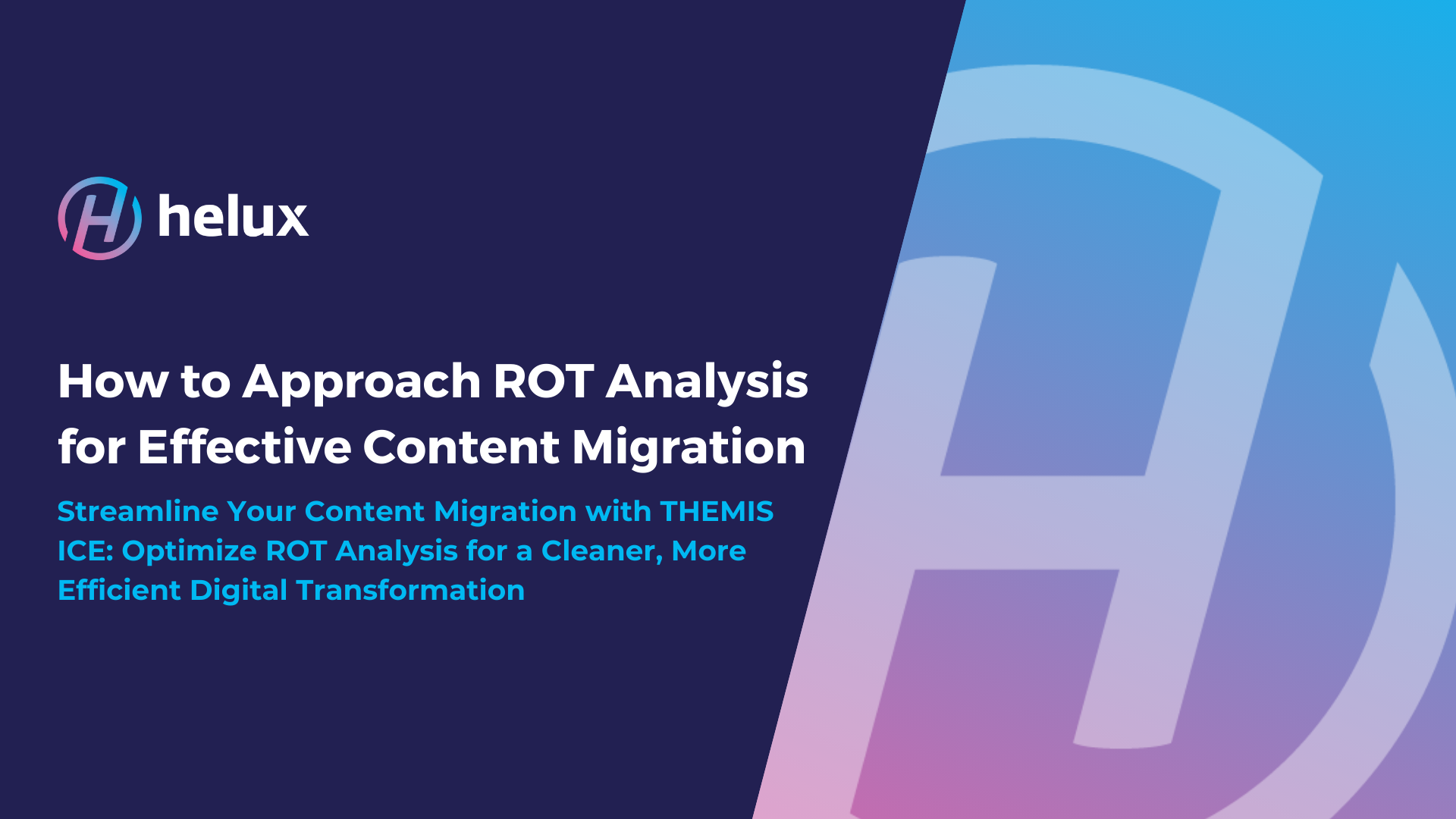How to Approach ROT Analysis for Effective Content Migration
In today’s data-driven world, organizations are managing more information than ever before. While having vast amounts of data can be a business asset, it can also present challenges when outdated, redundant, or unnecessary content clutters your systems. This is where ROT analysis—the process of identifying Redundant, Obsolete, and Trivial content—comes into play. By conducting a thorough ROT analysis before embarking on content migration, organizations can ensure a smooth and effective transition to new systems, such as SharePoint Online.
At HELUX, we specialize in helping organizations streamline content migration through intelligent tools like THEMIS ICE, which simplifies the ROT analysis process and enhances the efficiency of your content migration strategy. Below, we explore how to approach ROT analysis to ensure a successful content migration.
What is ROT Analysis?
ROT refers to content that is Redundant, Obsolete, or Trivial:
-
Redundant content is duplicated or repeated across your systems, unnecessarily consuming storage space.
-
Obsolete content is outdated information that no longer holds value to the organization.
-
Trivial content may include non-business-critical documents, personal files, or other content that doesn’t contribute to organizational goals.
ROT analysis aims to identify and eliminate this clutter, ensuring that only the most valuable and relevant information is migrated to your new system. This process not only improves efficiency but also enhances compliance, reduces costs, and improves searchability.
Why ROT Analysis is Critical for Content Migration
When organizations migrate to a new platform like SharePoint Online, they often make the mistake of migrating everything without first evaluating the value of the content. This can result in:
-
Increased costs: Migrating large volumes of unnecessary content can increase storage and management costs, particularly in cloud environments.
-
Slower migration times: Migrating ROT content prolongs the migration process and creates inefficiencies.
-
Reduced searchability: Migrating unneeded documents makes it harder for users to find the information they need, reducing productivity.
-
Compliance risks: Legacy content that hasn’t been reviewed for compliance could pose regulatory risks if not properly managed.
By performing ROT analysis before migrating, organizations can reduce these risks, streamline the migration process, and ensure that only high-value content is moved to the new environment.
Steps to Conduct ROT Analysis
A successful ROT analysis involves a structured approach. Here’s how you can approach it for effective content migration:
1. Identify ROT Criteria
Before diving into the analysis, define what constitutes redundant, obsolete, or trivial content for your organization. This may vary depending on your industry, regulatory requirements, and business needs. Common ROT indicators include:
-
Duplicate files
-
Documents that haven’t been accessed in years
-
Files that are irrelevant to current business processes
-
Personal files or unrelated materials in shared folders
2. Use Discovery Tools for ROT Identification
Manually identifying ROT content across an organization can be overwhelming, especially with large datasets. To make this process more efficient, use automated discovery tools that can scan your content repositories and flag ROT content.
THEMIS ICE is designed to assist in this process. Using intelligent content discovery, THEMIS ICE automatically identifies redundant, obsolete, and trivial content, helping you focus on valuable data. The platform's ability to auto-classify documents using AI further simplifies the ROT analysis.
3. Review and Validate ROT Findings
Once ROT content has been identified, the next step is to review and validate the findings. In some cases, content that appears obsolete or redundant might still hold value, so it’s important to involve stakeholders from across the organization to ensure the right decisions are being made.
Incorporating user feedback during this step ensures that critical business documents aren’t mistakenly flagged as ROT and deleted.
4. Establish Retention and Disposal Policies
Once ROT content has been validated, it’s crucial to establish clear policies for retention and disposal. Retention policies determine how long valuable documents should be kept, while disposal policies outline the proper procedures for deleting unnecessary content.
By enforcing these policies as part of your ROT analysis, you can ensure that content is managed systematically and in compliance with any legal or regulatory requirements.
5. Prepare for Migration
With ROT content identified and addressed, the final step is to prepare your remaining content for migration. At this stage, the content should be organized, classified, and tagged to ensure it is easy to manage in the new system. THEMIS ICE supports this process by auto-classifying documents using Microsoft Syntex, ensuring that only structured, organized information is migrated.
How THEMIS ICE Facilitates ROT Analysis and Content Migration
ROT analysis doesn’t need to be a time-consuming or manual task. With HELUX’s THEMIS ICE, organizations can automate much of the ROT identification process, allowing you to focus on high-value content for migration. Here’s how THEMIS ICE enhances the ROT analysis process:
-
Intelligent Content Discovery: THEMIS ICE automatically scans your content repositories to identify ROT content based on your criteria, reducing the need for manual review.
-
Auto-Classification: Leveraging the power of Microsoft Syntex, THEMIS ICE auto-classifies documents, ensuring that only relevant, well-organized content is migrated to your new system.
-
ROT Reporting: The platform provides detailed reports on ROT content, giving you the visibility needed to make informed decisions on what to retain, archive, or dispose of.
-
Seamless Migration: THEMIS ICE ensures that once ROT content has been dealt with, the remaining high-value content is migrated seamlessly to your new environment, improving overall data quality and management.
Content migration presents a unique opportunity to clean up your data and ensure only valuable information is transferred to your new systems. By approaching ROT analysis strategically, you can eliminate unnecessary clutter, reduce costs, and improve the efficiency of your migration.
HELUX’s THEMIS ICE is designed to simplify this process, helping you identify, classify, and migrate content with ease. Contact us today to learn more about how THEMIS ICE can streamline your content migration and make ROT analysis a seamless part of your digital transformation journey.

